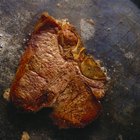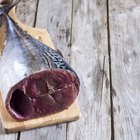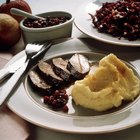
"Fat is Flavor" is a frequently echoed mantra in cooking, but it doesn't mean you have to settle for less when you have a lean steak. Axis deer steaks, for example, contain less than 1 percent fat, but are considered by some to be the best-tasting wild game meat. If you buttress an axis steak's natural flavor, which leans more to the beefy side than the gamey, with a slow pan braise or a quick sear-roast, you can develop rich, complex layers of flavor. Pan braising suits 1-inch-thick and larger steaks, while thinner steaks respond best to sear-roasting.
Pan Braising
Step 1
Marinate the axis deer steaks for one to two hours in cultured buttermilk. Buttermilk contains enzymes and lactic acid that work with enzymes in game meat to tenderize it more effectively than oil-and-acid marinades.
Step 2
Remove the steaks from the cultured buttermilk marinade and pat them dry with paper towels. Let the steaks reach room temperature on a plate or in a dish.
Step 3
Season the steaks to taste. Heat a few tablespoons of clarified butter or oil on the stove in a heavy-bottomed saute pan or cast-iron skillet over medium heat.
Step 4
Sear the steaks until golden-brown and caramelized on both sides, or about three minutes total. If you have a thick-cut axis steak, hold it with tongs and press the sides of it to the pan to sear them.
Step 5
Place the steaks on a plate and set them aside. Lower the heat to medium and add aromatic vegetables. A few cups of standard mirepoix, or two parts rough-chopped onions to one part each rough-chopped carrots and celery, works well as a base. You can add other vegetables, such as bell peppers, hot peppers and chopped garlic, to the mirepoix if desired.
Step 6
Saute the vegetables until caramelized and browned, about 10 minutes. Add a few cups of cold stock or broth to the pan to deglaze it while using a wooden spoon to scrape up the caramelized bits sticking to the bottom.
Step 7
Return the steaks to the pan, using the vegetables as a bed to place them on. Add enough stock or broth to reach at least halfway up the sides of the steaks. If the steaks have a lot of connect tissue, substitute some of the stock or broth for a can of peeled stew tomatoes. The citric acid in canned tomatoes works with the low heat to tenderize the steaks and melt the connective tissue.
Step 8
Add whole spices and fresh herbs to the pan, if desired. The spices and herbs infuse the steak with subtle flavors and aromas during braising.
Step 9
Adjust the heat so the liquid barely simmers. If the pan has a lid, cover it but leave it slightly ajar. Cover the pan loosely with a piece of aluminum foil if you don't have a lid.
Step 10
Braise until fork tender, or about one hour per pound. Turn the steaks over and check the level of the liquid after 30 minutes. Add more stock or broth as needed to keep it about halfway up the sides of the steaks.
Step 11
Remove the lid or foil during the last 20 minutes of braising. Remove the steaks and let them rest for 15 minutes per pound. Add equal parts butter and flour to the sauce and simmer while the steaks rest if you want to make a gravy. Season the gravy to taste when it has reached the desired consistency.
Sear-Roasting
Step 1
Remove the axis steaks from the refrigerator and let them sit at room temperature on a plate until they reach room temperature.
Step 2
Heat the oven to 500 degrees Fahrenheit. Heat a few tablespoons of oil or clarified butter in an oven-safe saute pan over medium-high heat.
Step 3
Pat the steaks dry with paper towels and season them to taste. Place the steaks in the pan and sear them on one side until golden-brown, about two minutes.
Step 4
Turn the steaks over with tongs and place the pan in the oven. Roast for about seven minutes for medium doneness, or an internal temperature of 145 F. If you need to check the temperature of the steaks, remove them from the pan first.
Step 5
Place the steaks on a plate and cover them loosely with aluminum foil. Rest the steaks for 15 minutes before serving.
Related Articles

How to Cook Kobe Steaks

How to Cook Churrasco Steak in a Pan

How to Cook Alligator Steak

Slow Cooking an Eye of the Round Steak ...

How to Smoke Tuna

How to Cook Pan Fried Deer Tenderloin

How to Cook Beef Tenderloin on a ...

How to Cook Rib Eye Steak in an ...

The Best Way to Cook Bison Steak

How to Cook Bone-In Pork Strips in the ...

How to Braise a Cross Rib Steak

How to Cook Dominican-Style Steak

How to Cook Venison Backstrap Steaks on ...

How to Cook a Breaded Thick Cube Steak

How to Cook Venison Steaks With Onions

How Do I Cook a Tuna Steak Without ...

How to Cook Deer Sirloin

How to Score a Steak

How to Broil Filet Mignon Wrapped in ...

How to Cook Moose Steaks
References
Tips
- Oven-safe pans are made of stainless-steel, anodized aluminum or cast-iron, and have metal handles. You can use high-temperature nonstick pans rated at 500 F or higher in the oven also.
Writer Bio
A.J. Andrews' work has appeared in Food and Wine, Fricote and "BBC Good Food." He lives in Europe where he bakes with wild yeast, milks goats for cheese and prepares for the Court of Master Sommeliers level II exam. Andrews received formal training at Le Cordon Bleu.
Photo Credits
John Foxx/Stockbyte/Getty Images